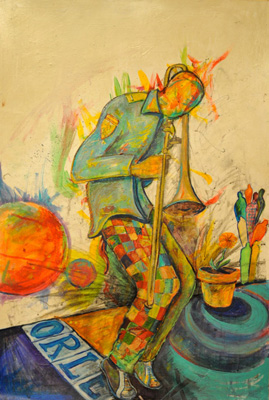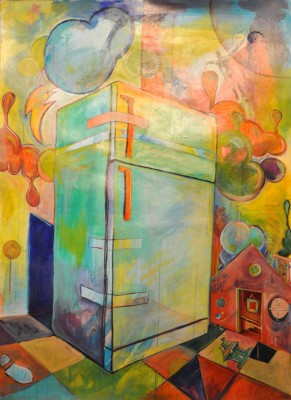Review: “Hue Orleans: Ayo Scott's Eye View”

Ayo Scott, orleans blues for a lady, 2011. Acrylic on paper. Photo by Nika B. Carter. Courtesy the artist and The George & Leah McKenna Museum of African American Art, New Orleans.
“Hue Orleans: Ayo Scott's Eye View”
The George & Leah McKenna Museum of African American Art
2003 Carondelet Street
June 24–August 20, 2011
The McKenna Museum of African American Art came to life on a recent Friday evening for the opening of Ayo Scott’s first major solo exhibition. The hundreds of viewers and well-wishers in attendance were a mixture of old established New Orleans families, regulars within the art community, friends (both old and new), as well as young nouveau art lovers who came, en masse, after the event was “blasted” via virtual media outlets.
Amid the party atmosphere, the artist could be found interacting with guests in front of his wall-sized, multi-hued, three-dimensional installation, which gave the illusion of stepping inside one of his paintings. The artist-curated exhibition is split into two rooms filled with large works on paper featuring Scott’s vibrant dreamlike vision of New Orleans and the Seventh Ward where he grew up.
His vivid color combinations, broad brush strokes, skewed perspectives, and simplified renderings convey a surreal, almost saccharine, sense of levity and childlike playfulness, juxtaposing often darker themes of loss, pain, and post-Katrina struggles. Scott transforms everyday objects into icons, such as taped-up refrigerators, Abita bottles, overflowing trashcans, and afro-combs magnified to epic proportions. In his hands, the now ubiquitous fleur-de-lis becomes a large oak tree with roots, the ultimate sign of hope and regeneration for the city and its people.
Though the work is mostly devoid of human figures, the importance of family and a love for the community in which he was raised is readily apparent. In orleans blues for a lady, an abstracted image of Trombone Shorty looms in the foreground; Scott’s mother and father (the celebrated artist John Scott) are represented by the objects of their affections—a flower pot and some of the elder Scott’s signature sculptural forms—receiving the life forces from the musician’s instrument.
A spontaneous and organic painter who is clearly moved by nature, Scott draws on artistic influences as varied as his paint colors. The heady lineup of twentieth-century painters he regards as influences not only include his father, but also abstract-realist, Francis Bacon; Mexican icon, Diego Rivera; contemporary figurative painter, Lucien Freud; and African-American abstractionist, Raymond Saunders. Although it is still early in the artist’s career to fully appreciate what was passed from father to son or what the weight of expectation will ultimately produce, it is evident from this exhibition that the path he travels will be of his own making.

Ayo Scott, where my heart used to be, 2011. Acrylic on paper. Photo by Nika B. Carter. Courtesy the artist and The George & Leah McKenna Museum of African American Art, New Orleans.



